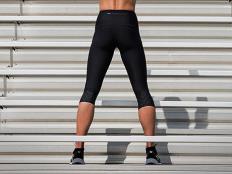In the healthy athlete, compression gear serves a different role. Most who choose to wear compression garments anticipate that they will experience improved circulation and mechanics. It is thought that compression garments may reduce muscle oscillations which will theoretically optimize the contraction direction of muscle fibers, resulting in improved mechanical efficiency and running kinematics.
Use of compression gear may also reduce vibration in skeletal muscle during training and competition. It is hypothesized that the reduced vibration would contribute to less muscle trauma, and as a result, less fatigue and biomechanical alterations during the course of an endurance event. Following the event, the combined benefit of these outcomes would be reduced exercise-induced muscle damage.
As a result, athletes are expected to experience less soreness, edema and faster recovery in the days after exercise.
More: Does Compression Wear Really Work?
Based on these speculative mechanisms of effect, marketing terminology for compression gear includes words such as improved thermoregulation, reduced muscle oscillation, and increased circulation. As an informed consumer, it is always good to take a look at the most recent data which is summarized below. Please keep in mind that the literature is difficult to interpret with one main stance on compression gear due to the experimental design discrepancies among various studies.
For example, there is significant variability among studies to include the type and duration of exercise, the measures used as indicators of performance or recovery, the training and health status of the participants, the duration that the compression garments were worn, the total duration of wear, the pressure applied and the area of the body covered.
What Does the Research Show?
Individual assessment of compression gear research shows some benefit, although it's mainly during the recovery process. For example, one report says no significant differences in sprint performance (time or distance covered), throwing performance (distance or accuracy), heart rate response or blood measures.
The one change observed during exercise was higher skin temperature. However, during the 24-hour period post-exercise, blood markers of muscle damage were lower and the athletes reported less soreness, according to the study by Duffield, R. and M. Portus, Comparison of three types of full-body compression garments on throwing and repeat-sprint performance in cricket players.
In another example, subjects performed 30-minute bouts of moderate and high-intensity running on a treadmill while wearing compression gear. According to the study by Lovell, D.I., Do compression garments enhance the active recovery process after high-intensity running? Decreased heart rate and lactic acid were documented during the recovery period post-exercise. The results of this study are encouraging as reducing lactic acid and recovery heart rate have important implications for athletes that perform repeated bouts of high-intensity exercise in a single competition.
- 2
- of
- 3
About the Author

Get ACTIVE on the Go


Couch to 5K®
The best way to get new runners off the couch and across the finish line of their first 5K.
Available for iOS | Android







Discuss This Article